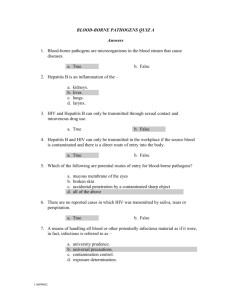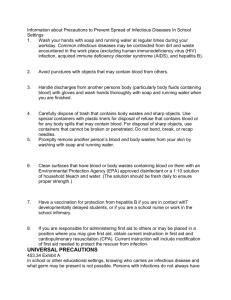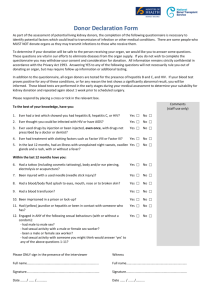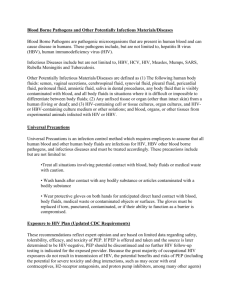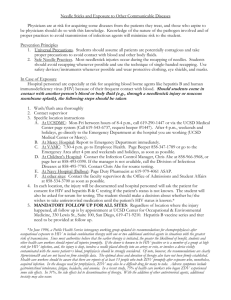Blood Borne Pathogens Standard Precautions
advertisement
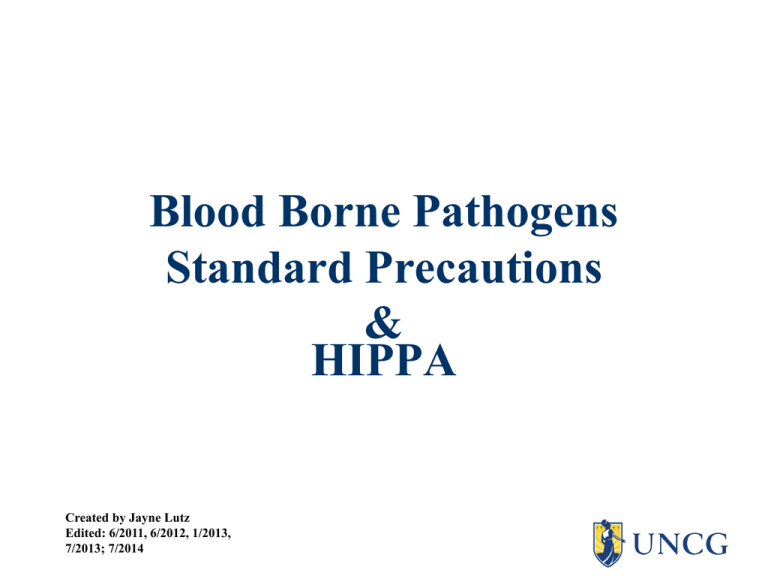
Blood Borne Pathogens Standard Precautions & HIPPA Created by Jayne Lutz Edited: 6/2011, 6/2012, 1/2013, 7/2013; 7/2014 OBJECTIVES At the end of this presentation the student will be able to: • Discuss the major Blood Borne Pathogens • Recognize potentially contaminated material • Identify exposure routes • Choose protection measures • Describe what to do in case of exposure as a UNCG School of Nursing student • Discuss the student responsibilities with HIPAA Major Blood Borne Pathogens • HIV • HEP B • HEP C Hepatitis B • Immunized per UNCG SON policy • No routine booster recommended for series completed prior to 1999 • Have a titer drawn only if exposed • If titer low then get a booster • Repeat titer as directed by provider • If titer remains low after boosterRepeat the entire series x 1 HBV Received Immunization Series for the First time after 2000: • Get test for surface antigen 1-2 mo. after series completed-do not wait longer or you may not get accurate results! • If this is negative repeat series x 1 • Repeat the titer again in 1-2 mo. following completion of second series • If negative again, do not repeat series..you are most likely protected but did not sero-convert Hepatitis C • No immunization available • Can live in a drop of dried blood for up to 4 days. • At least 4.1 million Americans have been infected • Estimated 3.2 million Americans living with chronic infection • Leading cause of liver failure in the US Hepatitis C • Acute & Chronic Hepatitis C • Acute develops into a chronic infection in 50-75% of all infected persons • Estimated that HEP C will cause more deaths in the USA than AIDS in the next decade • HCV related deaths will most likely double or triple in the next 10-20 years. • Many with chronic disease are now in the 40-65 age range. Hepatitis C (Continued) New treatment available is highly even if treatment started late in the disease process. Very expensive: $84,000 for six weeks of treatment. New meds are: Olysio and Sovaldi Hopefully these will eliminate the need to take interferon These drugs will need to be taken with ribavirin. Hepatitis C: The Course of the Disease • Acute infection= rarely recognized Flu-like symptoms or no symptoms • Evolution from acute phase to cirrhosis usually requires decades: average time is 20-30 years • When disease discovered, damage to the liver has most likely occurred. Recommendation for HCV • Born between 1945-1965 get tested once, regardless of risk factors. (CDC April 2013) • If you are a nurse with any exposure history: get tested. • If you have any of these risk factors: get tested. – Injection drug use – Straw or sniffer use for cocaine – Blood transfusion before 1982 – Use of blood clotting components before 1987 – Tattoos/piercings with questionable sterile technique – Occupational exposure to blood – Sexual contact with an infected partner (decreased risk) Hepatitis C: The Good News • There has been a decline in diagnosed new cases in the past five years • Hepatitis C is rarely spread from the mother to the baby at time of delivery HIV • There is no known cure for HIV although there are drugs that suppress the infection • HIV causes destruction of the immune system • The terminal state is acquired immunodeficiency syndrome (AIDS) • 1.1 million Americans living with HIV/AIDS & more than 1 in 6 are unaware HIV-Interesting Facts • Newly diagnosed cases highest in 25-34 age group • Adolescents-young adults show the second most rapid increase of any age group (age 15-24) • NC ranks #8 in the US for the rate of persons contracting HIV….increase. We were 10th 2 yrs. ago HIV • What is your risk? HIV • Less than 1% seroconversion rate for health care professionals if exposed to a known HIV positive source. • Taking *ZVD after exposure reduces seroconversion *Zidovudine Standard Precautions • A set of precautions designed to prevent transmission of HIV, HBV, and other blood borne pathogens • Blood and certain body fluids of all patients are considered potentially infectious Potentially Harmful Body Fluids with Universal/Standard Precautions Blood Semen Vaginal Secretions Pleural Fluid Cerebrospinal Fluid Synovial Fluid Synovial Fluid Pleural Fluid Peritoneal Fluid Pericardial Fluid Amniotic fluid Body Fluids to Which Universal/Standard Precautions Do Not Apply Unless Blood is Visible • • • • • • Feces Nasal secretions Sputum Sweat Tears Vomitus • Urine • Saliva • Breast milk* *only in large quantities (breast milk bank) Protect Yourself • • • • • • • Gloves Gown Apron Masks Hand washing Safety precautions with sharps Eye shields Biohazard Areas NOT ALLOWED IN A BIOHAZARD AREA: • Drink • Food • Cosmetics • Lip balm • Handling contact lenses ROUTES OF EXPOSURE An exposure occurs when blood (or other contaminated material contacts: • Non-intact skin (lowest risk) • Mucous membrane(medium risk)* • Injected, especially deep injection(highest risk) • * The most common exposure site Course of Action if Exposed • Flush splashes to nose, mouth, or skin with water • Irrigate eyes with water or saline • Report to faculty and preceptor • Seek counseling/care within 1-2 hours* after exposure. • *post exposure prophylaxis effective if started up to 7 hours after exposure although 1-2 hours preferred Course of Action if Exposed The location of your treatment is your choice: • Your clinical site~ if they have agreed & have the medication you may need • Your personal physician • Gove Student Health Center= • M-F: 8a-8p; Sat. 9-12 ; Sun. 5-8. • Phone: 334-5340 Phone Calls You Need to Make if You Are Exposed Gove Student Health Center: 334-5230 If you receive your counseling at the Student Health Center they will contact Moses Cone and facilitate care for you there if it is determined you need treatment. Notify faculty and preceptor Who Pays for Your Care? • You are responsible • The University does not cover these costs. HIPAA • Health Insurance Portability and Accountability Act • A Federal Law that sets standards to protect a patient’s health information • Standards protect the use and sharing of verbal, written, and electronic patient information What is Protected Health Information-PHI? • Information that: • Identifies the individual • Relates to the patient’s health, treatment or payment plan • Is kept or released • Electronically • On paper • Orally Why is Privacy Important? • Patients have a right to privacy • Violation of patient’s privacy (confidentiality) can affect the personal lives and careers of patients It is your job to protect patient privacy What is Your Role with HIPAA? • Keep oral, written, printed, & electronic reports private and secure • Keep telephone calls confidential • Protect computer passwords • *Remove patient/client names or other identifying information before throwing away papers • Refer to patients/clients by initials as Mr. or Ms. J.D, etc in journals/reports. *The best action is to shred all such papers Information that can be Given Out Without Prior Consent • Communicable diseases: Certain diseases must be reported to Public Health Agencies. • Reports to 3rd party payers: To verify medical treatment for insurance claims including Medicare payments. Questions or Concerns? • Contact your clinical faculty member. The End!

